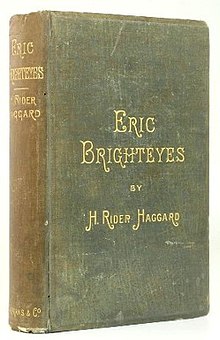Eric Brighteyes

First edition (publ. Longman)
|
|
| Author | H. Rider Haggard |
|---|---|
| Country | United Kingdom |
| Language | English |
| Publisher | Longmans & Co. |
|
Publication date
|
1890 |
The Saga of Eric Brighteyes is the title of an epic viking novel by H. Rider Haggard, and concerns the adventures of its eponymous principal character in 10th century Iceland. The novel was first published in 1890 by Longmans, Green & Company. It was illustrated by Lancelot Speed.
Eric Thorgrimursson (nicknamed "Brighteyes" for his most notable trait), strives to win the hand of his beloved, Gudruda the Fair. Her father Asmund, a priest of the old Norse gods, opposes the match, thinking Eric a man without prospects. But deadlier by far are the intrigues of Swanhild, Gudruda's half-sister and a sorceress who desires Eric for herself. She persuades the chieftain Ospakar Blacktooth to woo Gudrida, making the two men enemies. Battles, intrigues, and treachery follow.
Haggard wrote the book in late 1888 following a trip to Iceland.
The novel was an early example (and Haggard's introduction implies it was the first) of modern efforts in English at pastiching Viking saga literature. It clearly shows the influence of the pioneering saga translations by William Morris and Eirikr Magnusson in the late 1860s. While it is perhaps not quite a match for Frans Gunnar Bengtsson's genre-defining 1941 novel Röde Orm (later expanded and better known as The Long Ships), Bengtsson had the advantage of being culturally closer to his sources. For saga pastiches originating in English, Eric Brighteyes set a standard of quality and fidelity to the saga style that remained unmatched until Poul Anderson's novel The Broken Sword, 60 years later.
A curious effect of Haggard's successful emulation of the terse, pithy style of saga prose is that the idiom of this novel actually seems rather less dated in the early 21st century than Haggard's other work or the general run of Victorian adventure fiction. Improvements in our understanding of the Viking period have done surprisingly little to falsify Haggard's imagination of its setting, and the book should still hold appeal to any reader interested in the period.
...
Wikipedia
